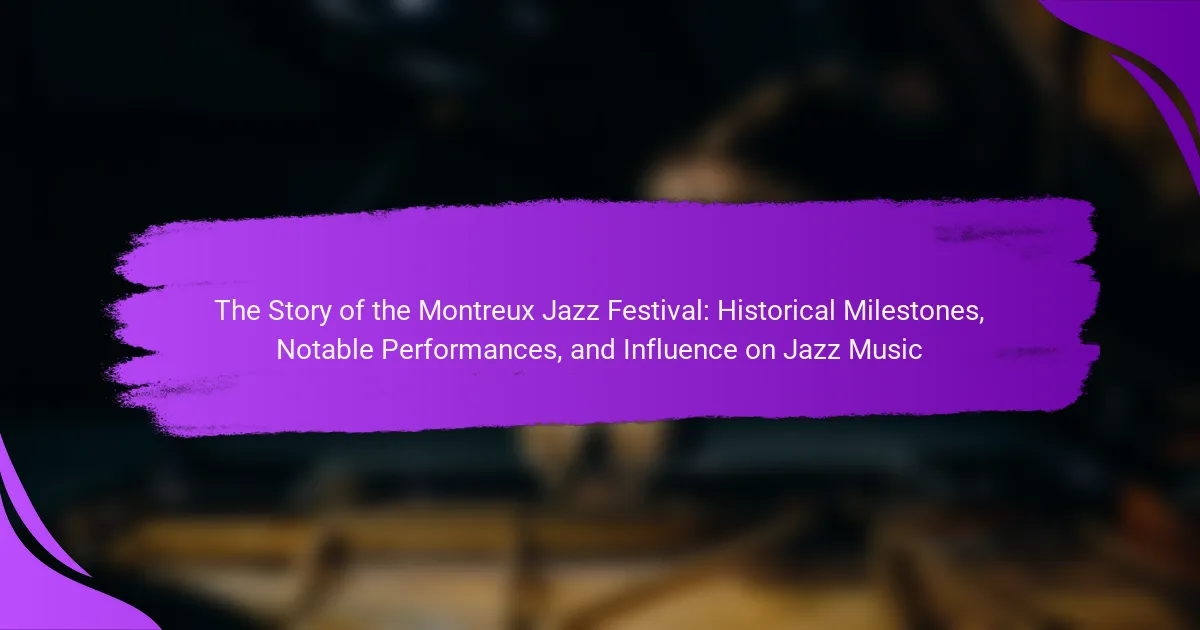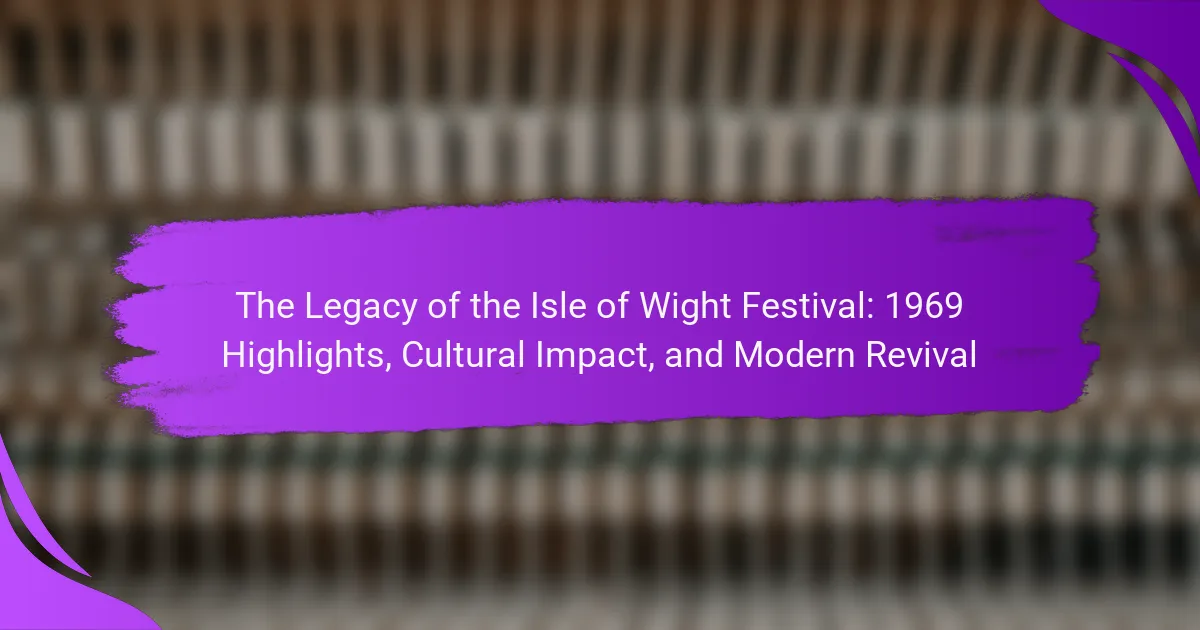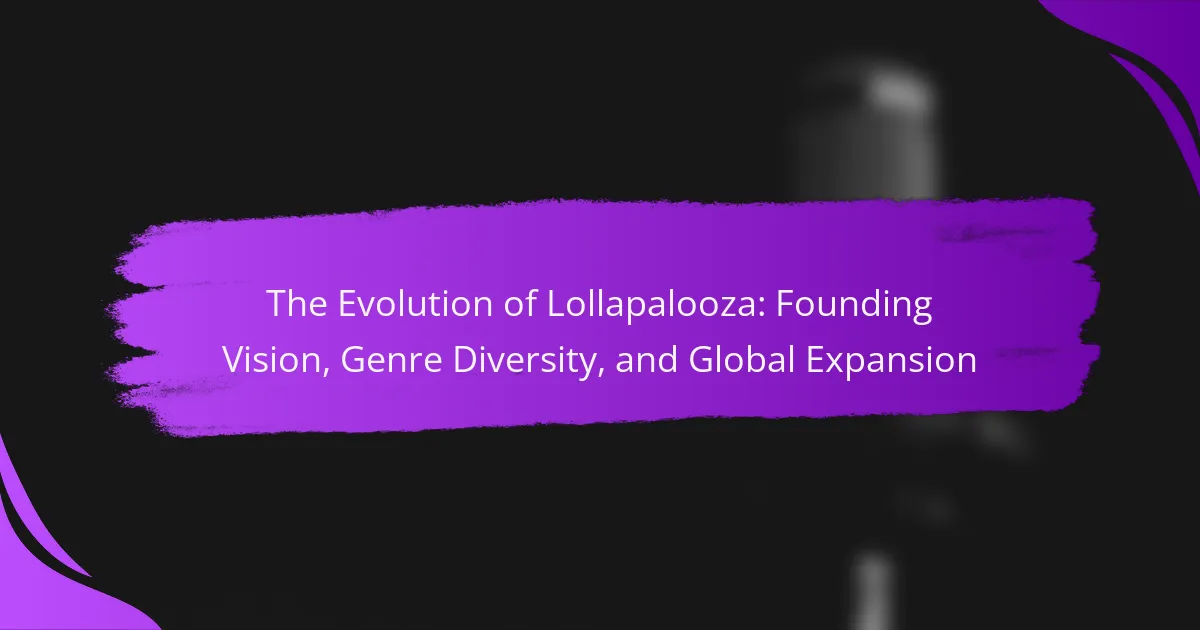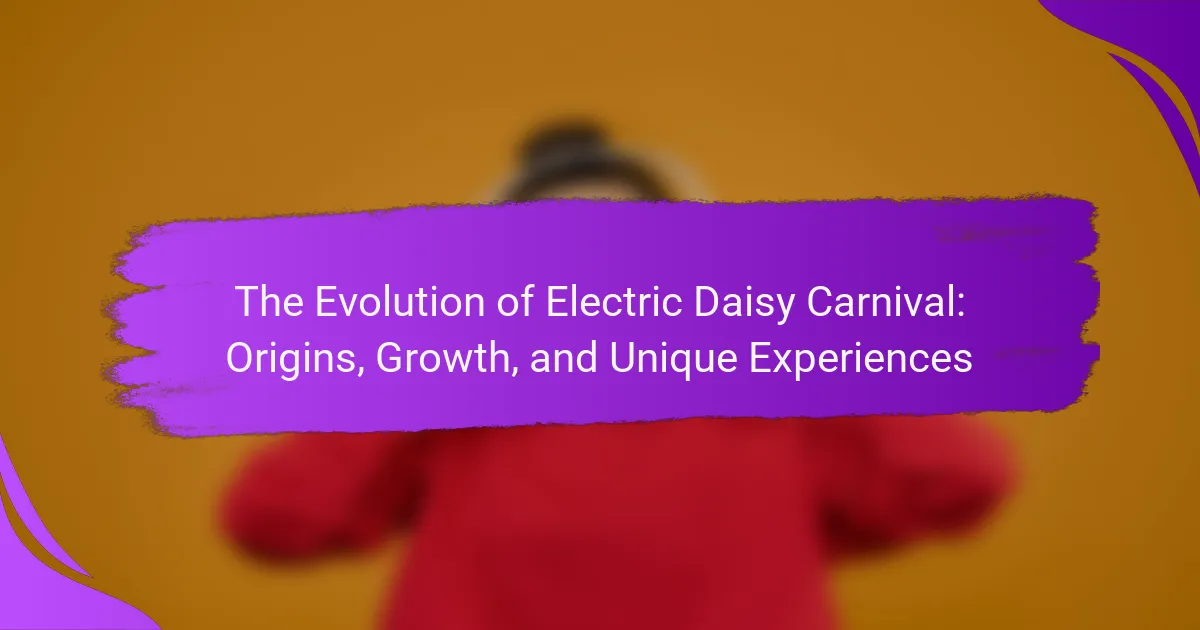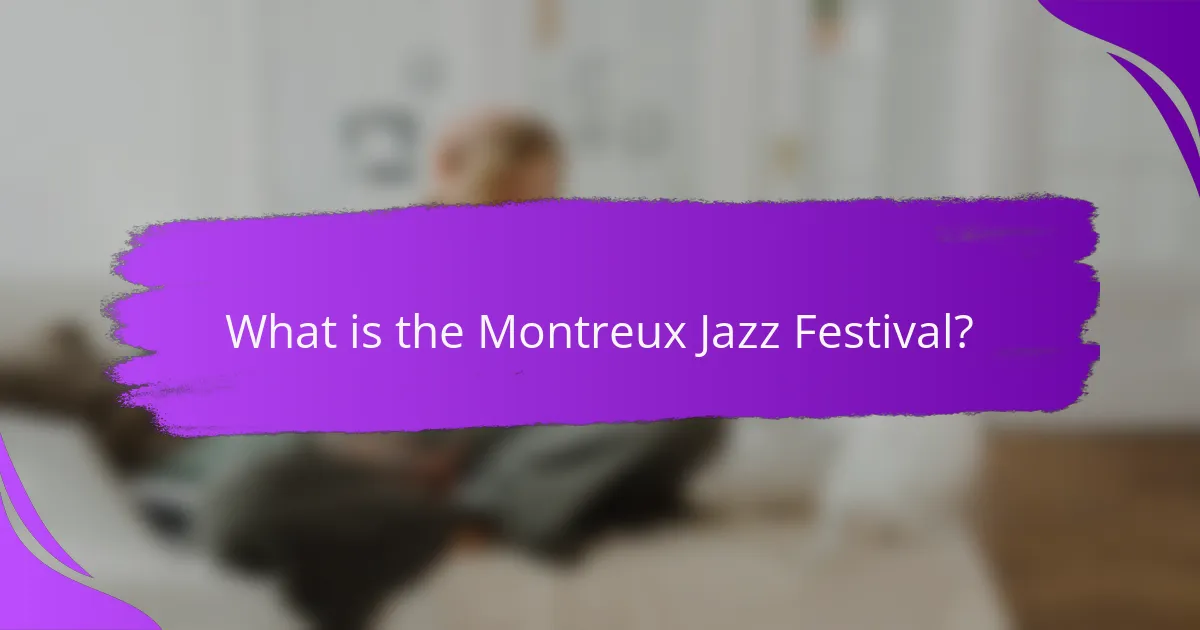
What is the Montreux Jazz Festival?
The Montreux Jazz Festival is an annual music festival held in Montreux, Switzerland. It was founded in 1967 by Claude Nobs, a local entrepreneur. The festival originally focused on jazz music but has since expanded to include various genres. Artists from around the world perform at the festival, attracting large audiences. Notable performers include legends like Nina Simone and Prince. The festival takes place every July along the shores of Lake Geneva. It has become one of the most famous music festivals globally. The event significantly influences the music industry and jazz culture.
How did the Montreux Jazz Festival begin?
The Montreux Jazz Festival began in 1967. It was founded by Claude Nobs, a Swiss entrepreneur. Nobs aimed to create a platform for jazz music. The first festival featured a small lineup of artists. It was held in Montreux, Switzerland, on the shores of Lake Geneva. Over the years, it expanded to include various music genres. The festival quickly gained international recognition. Today, it is one of the most prestigious music festivals globally.
What were the founding principles of the Montreux Jazz Festival?
The founding principles of the Montreux Jazz Festival were to promote jazz music and create a platform for artistic expression. Established in 1967 by Claude Nobs, the festival aimed to celebrate musical diversity. It sought to bring together artists from various genres, not just jazz. The festival emphasized high-quality performances and unique collaborations. It also focused on creating a welcoming atmosphere for both artists and audiences. Over the years, it has maintained a commitment to innovation in music. The Montreux Jazz Festival has grown to include a wide range of musical styles while staying true to its roots.
Who were the key figures in establishing the festival?
The key figures in establishing the Montreux Jazz Festival were Claude Nobs, Géo Voumard, and André Francis. Claude Nobs was the founder of the festival in 1967. He played a crucial role in its development and growth. Géo Voumard contributed significantly to the festival’s early programming. André Francis, a prominent figure in the music industry, helped shape the festival’s artistic direction. Their combined efforts established the Montreux Jazz Festival as a major cultural event. The festival has since become a platform for numerous legendary performances and artists.
What is the significance of the Montreux Jazz Festival in music history?
The Montreux Jazz Festival is significant in music history as one of the most renowned jazz festivals globally. Established in 1967, it has showcased a diverse range of artists across genres. The festival emphasizes the fusion of jazz with other musical styles, influencing the evolution of contemporary music. Notable performances include those by legends like Nina Simone and Prince. The festival’s unique setting on Lake Geneva enhances its cultural allure. It has become a platform for emerging talent, contributing to the careers of many musicians. The Montreux Jazz Festival also plays a key role in promoting music education and appreciation. Its historical impact on both jazz and popular music is widely recognized.
How has the festival evolved over the years?
The Montreux Jazz Festival has evolved significantly since its inception in 1967. Initially focused on jazz music, the festival has expanded to include various genres such as rock, pop, and electronic music. The first festival featured only a handful of artists, while recent editions showcase over 300 performances. Attendance has grown from around 1,000 attendees in the first year to over 250,000 in recent years. The festival has also embraced technology, introducing live streaming and digital platforms for global audiences. Notable performances have included legends like Nina Simone and Prince, highlighting its diverse lineup. The festival’s location along Lake Geneva has remained a constant, enhancing its appeal. Overall, the Montreux Jazz Festival has transformed into a major cultural event, reflecting changes in music trends and audience preferences.
What role has the festival played in promoting jazz music?
The Montreux Jazz Festival has played a significant role in promoting jazz music globally. Established in 1967, it has become one of the most prestigious music festivals. The festival showcases a diverse lineup of jazz artists, both established and emerging. It provides a platform for artists to perform in front of international audiences. This exposure helps in the discovery of new talent and the evolution of jazz. The festival has also inspired collaborations between jazz musicians and artists from other genres. Over the years, it has hosted legendary performances that have defined jazz history. The Montreux Jazz Festival has contributed to the cultural significance of jazz music worldwide.
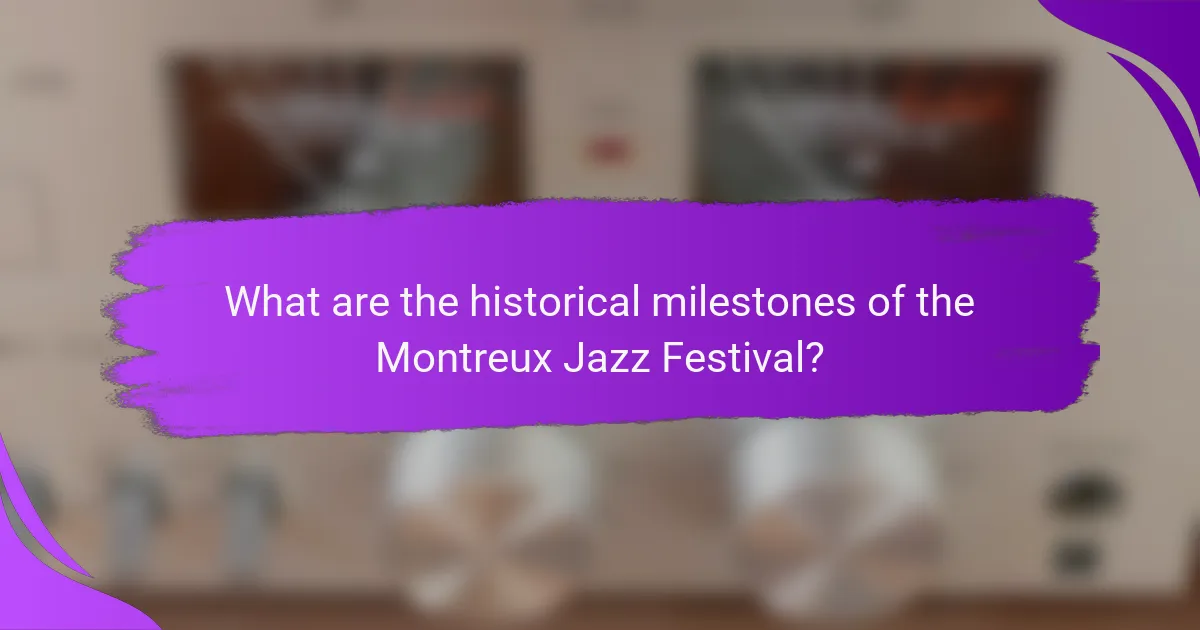
What are the historical milestones of the Montreux Jazz Festival?
The Montreux Jazz Festival began in 1967. It was founded by Claude Nobs and his friends. The festival initially focused on jazz music. Over the years, it expanded to include various genres. In 1971, the festival moved to the Montreux Casino. The famous fire incident occurred in 1971, impacting the festival’s venue. In 1991, the festival celebrated its 25th anniversary. The Montreux Jazz Café opened in 2000, enhancing the festival’s brand. In 2013, the festival introduced a new digital platform for music access. The Montreux Jazz Festival remains one of the world’s most prestigious music festivals.
What were the major milestones in the festival’s history?
The Montreux Jazz Festival has several major milestones in its history. It began in 1967, founded by Claude Nobs, with its first edition featuring 12 concerts. In 1971, the festival expanded to include a wide range of genres beyond jazz. The iconic Montreux Casino fire occurred in 1971, which led to the creation of the “Montreux Casino” album by Deep Purple. In 1991, the festival celebrated its 25th anniversary, marking a significant milestone in its growth. In 2003, the festival launched the Montreux Jazz Academy to support emerging artists. The festival’s 50th anniversary was celebrated in 2017, highlighting its long-standing influence on music. Each of these milestones reflects the festival’s evolution and cultural significance in the music industry.
Which years marked significant changes or developments?
1971, 1973, 1981, 1990, and 2003 marked significant changes at the Montreux Jazz Festival. In 1971, the festival expanded its genre scope beyond jazz. The 1973 edition introduced the iconic Montreux Casino, enhancing the festival’s profile. In 1981, the festival faced challenges with a fire, leading to a reimagined format. The 1990 festival featured a historic performance by Miles Davis, showcasing its global impact. In 2003, the festival celebrated its 37th edition with diverse artists, solidifying its legacy in music history.
How did the festival adapt to changes in the music industry?
The Montreux Jazz Festival adapted to changes in the music industry by diversifying its musical genres. Initially focused on jazz, the festival began incorporating rock, pop, and electronic music. This shift attracted a broader audience and enhanced its relevance. The festival also embraced technological advancements, such as live streaming performances. This allowed global access to its events, increasing its reach and engagement. Additionally, the festival collaborated with emerging artists and established acts alike. These adaptations ensured its longevity and continued influence in the evolving music landscape.
What notable performances have taken place at the Montreux Jazz Festival?
Notable performances at the Montreux Jazz Festival include those by legendary artists such as Nina Simone, Miles Davis, and Prince. Nina Simone performed in 1969, captivating the audience with her powerful voice. Miles Davis took the stage in 1973, showcasing his innovative jazz fusion style. Prince’s performance in 1986 is remembered for its energy and musicianship. Other significant acts include Ella Fitzgerald and Ray Charles, both of whom left a lasting impact on the festival’s history. The festival has hosted over 16,000 artists since its inception in 1967, solidifying its reputation as a premier music event. Each performance contributes to the festival’s legacy within the jazz genre.
Who are some of the legendary artists that have performed there?
Some legendary artists that have performed at the Montreux Jazz Festival include Frank Zappa, Nina Simone, and Miles Davis. Frank Zappa headlined the festival multiple times, showcasing his innovative approach to music. Nina Simone’s performances were noted for their emotional depth and powerful vocals. Miles Davis brought his jazz fusion style to the festival, influencing generations of musicians. Other notable artists include Prince, Aretha Franklin, and David Bowie, each leaving a significant mark on the festival’s legacy.
What memorable moments have defined the festival’s legacy?
The Montreux Jazz Festival’s legacy is defined by several memorable moments. One key moment occurred in 1971 when Frank Zappa performed, which marked a significant shift in the festival’s musical diversity. In 1973, the iconic performance by The Band solidified the festival’s reputation for showcasing legendary artists. The 1994 concert featuring Nina Simone was a poignant highlight, celebrated for her powerful vocal delivery. Another defining moment was the 2006 tribute to Ray Charles, which brought together numerous artists to honor his influence. Additionally, the 2013 performance by Prince showcased the festival’s ability to attract contemporary music icons. These events collectively illustrate the festival’s evolution and its impact on the jazz music landscape. Each moment reflects a commitment to artistic excellence and cultural significance.
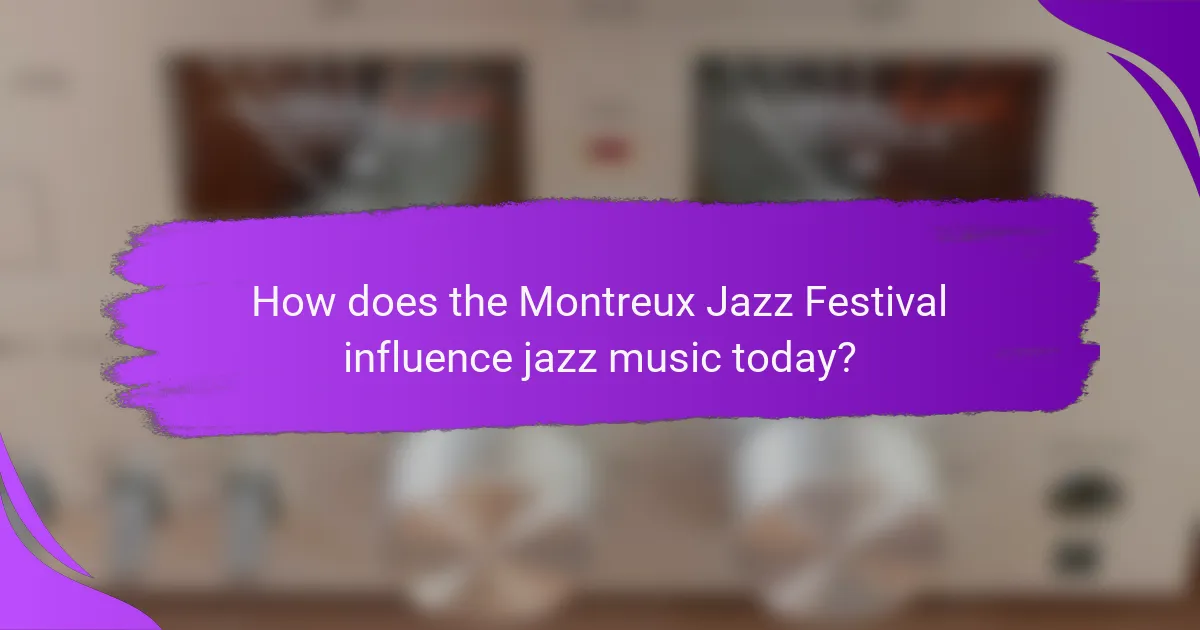
How does the Montreux Jazz Festival influence jazz music today?
The Montreux Jazz Festival significantly influences jazz music today by showcasing diverse artists and styles. It serves as a platform for both established and emerging musicians. This festival has introduced numerous genres beyond jazz, including rock, blues, and electronic music. Notable performances by legends like Miles Davis and Nina Simone have left a lasting impact on the genre. The festival’s commitment to innovation encourages artists to experiment with their sound. Additionally, it fosters collaboration among musicians from different backgrounds. The Montreux Jazz Festival also promotes jazz education through workshops and masterclasses. Its global reach helps to popularize jazz worldwide, ensuring its relevance in contemporary music.
What impact does the festival have on contemporary jazz artists?
The Montreux Jazz Festival significantly impacts contemporary jazz artists by providing a prestigious platform for exposure. Artists gain visibility to international audiences, enhancing their careers. The festival hosts renowned musicians, creating networking opportunities for emerging talents. Collaborations often arise from these interactions, fostering innovation in the jazz genre. Additionally, the festival showcases diverse styles, encouraging artists to experiment with their sound. Historical performances have led to the discovery of new talent, influencing future generations. The festival’s recordings contribute to the artists’ discographies, increasing their reach and legacy. Overall, the Montreux Jazz Festival plays a crucial role in shaping the careers of contemporary jazz artists.
How does the festival support emerging talent in the jazz scene?
The Montreux Jazz Festival supports emerging talent in the jazz scene through various initiatives. It provides a platform for new artists to perform alongside established musicians. The festival features dedicated stages for up-and-coming acts, ensuring visibility. Additionally, it offers mentorship programs connecting emerging artists with industry professionals. The festival also hosts workshops and masterclasses, promoting skill development. Financial support is available through grants and competitions for young musicians. These efforts contribute to the growth and sustainability of the jazz genre.
What collaborations have emerged from the festival?
Numerous collaborations have emerged from the Montreux Jazz Festival. Notable partnerships include those between artists from different genres. For instance, the festival has seen jazz musicians collaborate with rock and pop artists. These collaborations often result in unique performances that blend various musical styles. The festival serves as a platform for artists to experiment and innovate together. Historical performances include collaborations like those between Miles Davis and various contemporary artists. Such partnerships have contributed to the festival’s reputation for fostering musical creativity. The Montreux Jazz Festival continues to be a catalyst for collaborative projects in the music industry.
What are the future prospects for the Montreux Jazz Festival?
The future prospects for the Montreux Jazz Festival appear promising. The festival continues to attract a diverse lineup of artists annually. Recent years have seen increased attendance, indicating sustained interest. The festival’s commitment to innovation in music programming enhances its appeal. Collaborations with emerging artists and genres are expanding its audience base. Additionally, the festival’s historical significance contributes to its ongoing relevance in the music industry. Investment in digital platforms enhances global reach and engagement. Overall, the Montreux Jazz Festival is well-positioned for continued success and growth.
How is the festival adapting to modern trends in music?
The Montreux Jazz Festival is adapting to modern trends in music by incorporating diverse genres beyond jazz. It features contemporary artists from pop, rock, and electronic music, attracting a wider audience. The festival also utilizes digital platforms for ticket sales and streaming performances online. This enhances accessibility for global fans. Collaborations with emerging artists are prioritized, showcasing new talent alongside established names. The festival’s programming reflects current musical trends and cultural shifts. Additionally, it embraces innovative technologies like virtual reality experiences for attendees. These adaptations ensure the festival remains relevant in today’s evolving music landscape.
What initiatives are being introduced to enhance the festival experience?
New initiatives at the Montreux Jazz Festival focus on improving attendee engagement and accessibility. Enhanced digital platforms offer real-time updates and interactive schedules. Sustainability measures include eco-friendly practices and waste reduction strategies. Expanded food and beverage options cater to diverse dietary needs. Family-friendly activities are introduced to attract a wider audience. VIP experiences provide exclusive access to artists and special events. Collaborations with local artists promote regional culture and creativity. These initiatives aim to create a more inclusive and memorable festival atmosphere.
What tips can attendees follow to enhance their Montreux Jazz Festival experience?
Attendees can enhance their Montreux Jazz Festival experience by planning ahead. Research the lineup to prioritize must-see performances. Arrive early to secure good viewing spots. Explore the festival grounds for food and merchandise. Engage with other attendees to share experiences. Attend workshops and panel discussions for deeper insights. Utilize public transport for easier access to the venue. Stay hydrated and take breaks to enjoy the atmosphere. These tips help maximize enjoyment and participation in the festival.
The Montreux Jazz Festival is a renowned annual music festival held in Montreux, Switzerland, since 1967, originally focused on jazz but now encompassing various genres. The article covers the festival’s historical milestones, key figures in its establishment, and its evolution over the years, highlighting notable performances by legendary artists such as Nina Simone and Prince. It also explores the festival’s significant influence on jazz music, its support for emerging talent, and its adaptation to modern trends. Additionally, the article outlines initiatives aimed at enhancing the festival experience for attendees.
